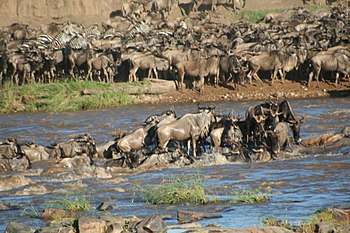Migration (ecology)
Migration, in ecology, is the large-scale movement of members of a species to a different environment. Migration is a natural behavior and component of the life cycle of many species of mobile organisms, not limited to animals, though animal migration is the best known type. Migration is often cyclical, frequently occurring on a seasonal basis, and in some cases on a daily basis[1]. Species migrate to take advantage of more favorable conditions with respect to food availability, safety from predation, mating opportunity, or other environmental factors.[2][3]

While members of some species learn a migratory route on their first journey with older members of their group, other species genetically pass on information regarding their migratory paths.[4]:71-72 Despite many differences in organisms’ migratory cues and behaviors, “considerable similarities appear to exist in the cues involved in the different phases of migration.”[4]:84 Migratory organisms use environmental cues like photoperiod and weather conditions as well as internal cues like hormone levels to determine when it is time to begin a migration. Migratory species use senses such as magnetoreception or olfaction to orient themselves or navigate their route, respectively.[4]:69-70
The factors that determine migration methods are variable due to the inconsistency of major seasonal changes and events. When an organism migrates from one location to another, its energy use and rate of migration are directly related to each other and to the safety of the organism. If an ecological barrier presents itself along a migrant’s route, the migrant can either choose to use its energy to cross the barrier directly or use it to move around the barrier. If an organism is migrating to a place where there is high competition for food or habitat, its rate of migration should be higher. This indirectly helps determine an organism’s fitness by increasing the likelihood of its survival and reproductive success.[4]:38-41
Types of migration include:
- Animal migration, the physical movement by animals from one area to another
- Bird migration, the regular seasonal journey undertaken by many species of birds
- Reverse migration, a phenomenon in bird migration
- Fish migration, the regular journey of fish
- Insect migration, the seasonal movement of insects
- Lepidoptera migration, the movement of butterflies and moths
- Bird migration, the regular seasonal journey undertaken by many species of birds
- Diel vertical migration, a daily migration undertaken by some ocean organisms
Effects of migration
A species migrating to a new community can affect the outcome of local competitive interactions. A species that migrates to a new community can cause a top-down effect within the community. If the migratory species is abundant in the new community, it can become a main prey for a resident predator, leaving other resident species as only an alternate prey. This new source of food (migrants) can increase the predatory species’ population size, impacting population sizes of its other prey when the migratory species return to their original location.[4]:136 If a resident species experiences a scarcity of food due to seasonal variation, the species can decrease in population, creating an opportunity for a new species to migrate to that location as the decrease in the population of the resident species leaves an abundance of food.[4]:135 Migratory species can also transport diseases long-distance from their original habitat.[4]:137
See also
- Animal navigation, abilities used by animals to navigate
- Great American Interchange, an event in which fauna migrated between North America and South America one the continents were bridged by the Isthmus of Panama
- Human migration, physical movement by humans from one area to another
- Plant migration, or seed dispersal, the movement or transport of seeds away from the parent plant
- Forest migration, the movement or transport of large seed plant dominated communities in geographical space over time
References
- https://academic.oup.com/bioscience/article/57/2/113/228325
- "Migration and dispersal". Wrexham Glyndŵr University. Archived from the original on October 10, 2017.
- Dorst, Jean P. "Ecological Significance of Migration". Encyclopedia Britannica. Retrieved 7 December 2017.
- Animal migration : a synthesis. Milner-Gulland, E. J.,, Fryxell, John M., 1954-, Sinclair, A. R. E. (Anthony Ronald Entrican). Oxford. ISBN 9780191576621. OCLC 795706827.CS1 maint: others (link)